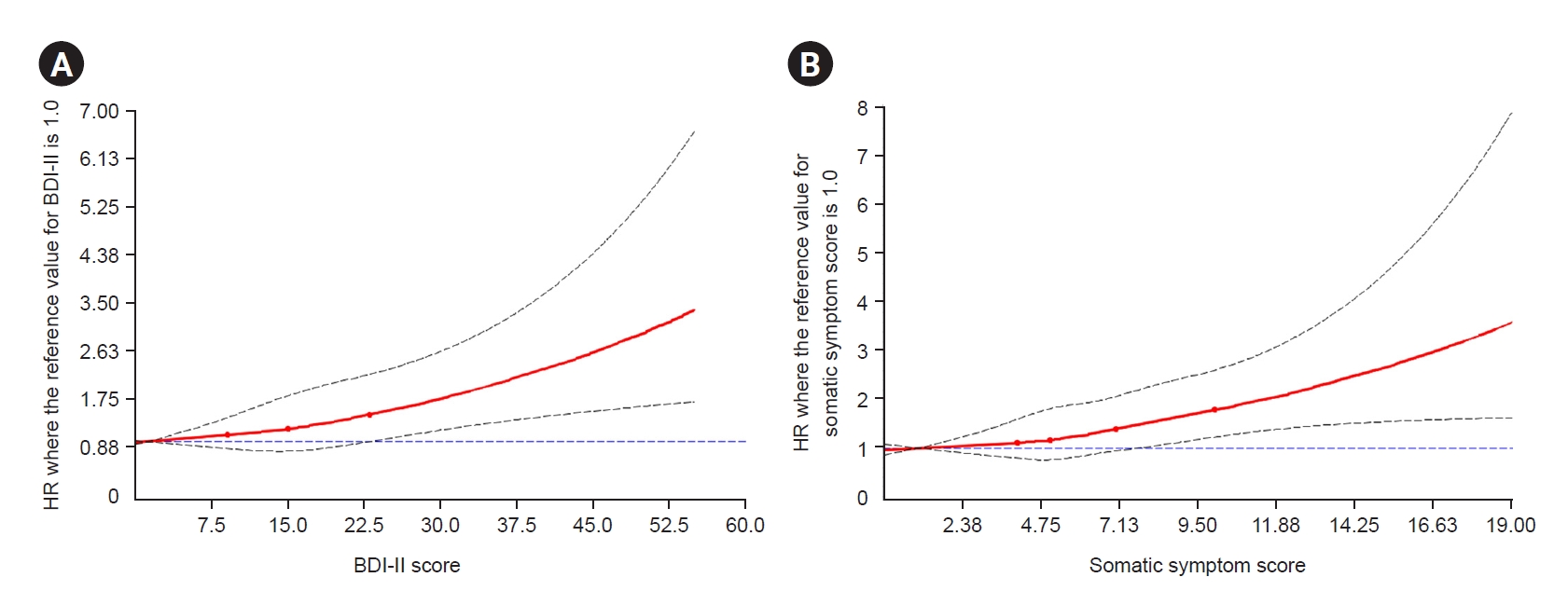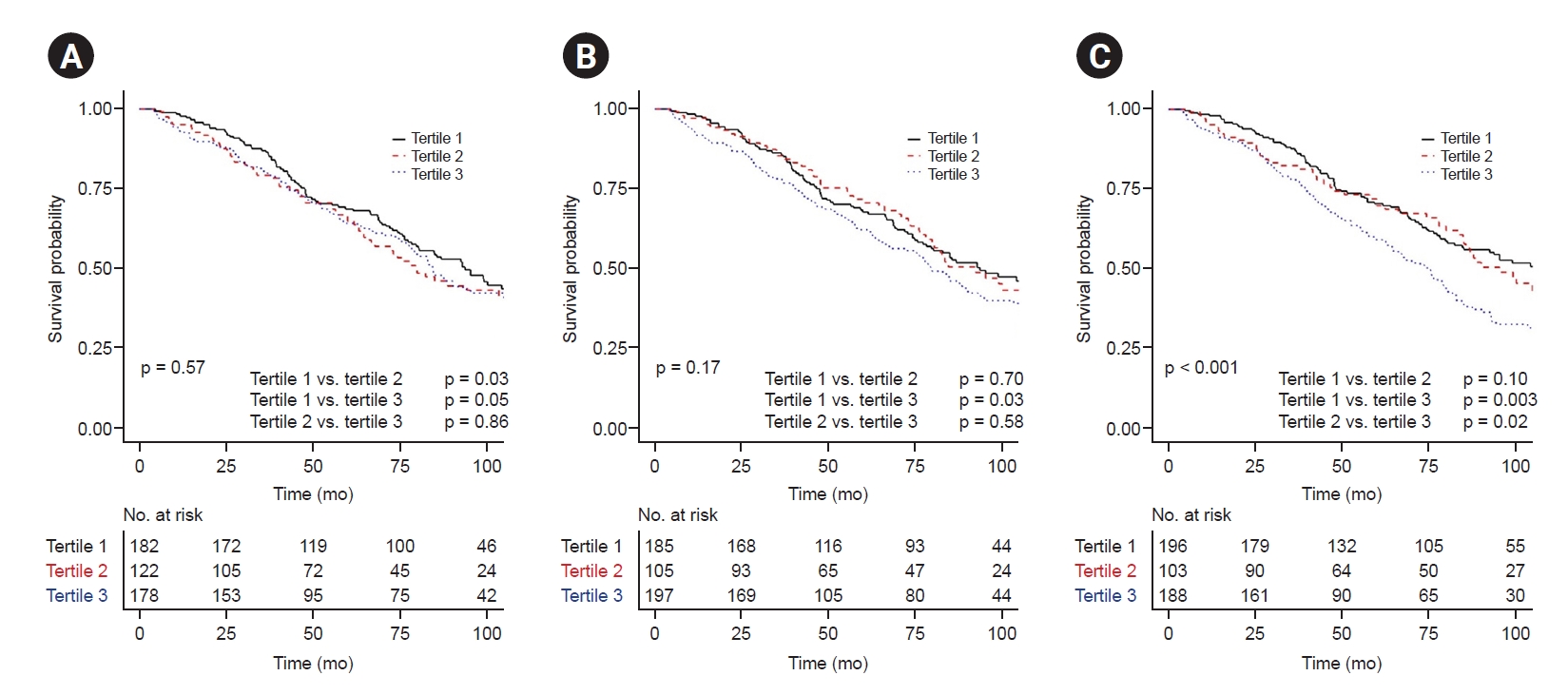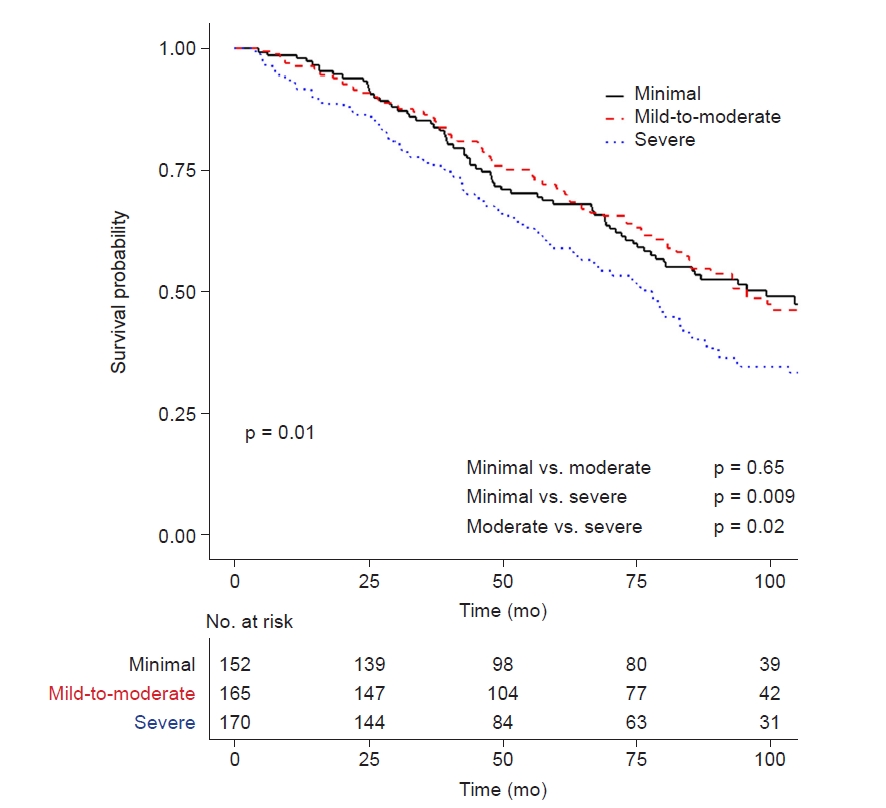| Kidney Res Clin Pract > Epub ahead of print |
Abstract
Background
Methods
Results
Supplementary Materials
Notes
Funding
This work was supported by a grant from Biomedical Research Institute, Kyungpook National University Hospital (2022).
Data sharing statement
The data presented in this study are available on request from the corresponding author.
Authors’ contributions
Conceptualization, Investigation: JHL, YLK, JHC
Data curation: YSK, SWK, CWY, NHK, HYJ, JYC, SHP, CDK
Statistical analysis, Visualization: JHL, YJ
Funding acquisition, Supervision: YKC, JHC
Methodology: JHL, HYJ, JYC, SHP, CDK, YLK, JHC
Writing–original draft: YHJ, JHL
Writing–review & editing: YHJ, JHL, YLK, JHC
All authors read and approved the final manuscript.
Figure 1.
Relationship between the mortality hazard ratio and depressive symptom scores.

Figure 3.
Kaplan-Meier curves for mortality according to three depressive symptom scores in tertile groups.

Table 1.
| Characteristic |
Depression group |
p-value | ||
|---|---|---|---|---|
| Minimal | Mild-to-moderate | Severe | ||
| No. of patients | 152 | 165 | 170 | |
| Age (yr) | 65.9 ± 7.2 | 66.0 ± 6.6 | 67.1 ± 7.1 | 0.24 |
| Male sex | 102 (67.1) | 96 (58.2) | 107 (62.9) | 0.26 |
| BMI (kg/m2) | 23.3 ± 3.4 | 23.4 ± 3.5 | 22.8 ± 3.4 | 0.27 |
| BDI-II score | 5.2 ± 3.3 | 14.7 ± 2.5 | 24.9 ± 7.9 | <0.001 |
| Primary renal disease | 0.20 | |||
| Diabetes | 86 (56.6) | 108 (65.5) | 104 (61.2) | |
| Hypertension | 32 (21.1) | 20 (12.1) | 21 (12.4) | |
| Glomerulonephritis | 13 (8.6) | 13 (7.9) | 12 (7.1) | |
| Others | 21 (13.8) | 24 (14.6) | 33 (19.4) | |
| Comorbid conditions | ||||
| Diabetes | 91 (59.9) | 116 (70.3) | 113 (66.5) | 0.14 |
| Congestive heart failure | 19 (12.5) | 32 (19.4) | 32 (18.8) | 0.20 |
| Peripheral vascular disease | 7 (4.6) | 24 (14.6) | 22 (12.9) | 0.01 |
| Cerebrovascular disease | 12 (7.9) | 17 (10.3) | 29 (17.1) | 0.03 |
| Chronic lung disease | 14 (9.2) | 7 (4.2) | 18 (10.6) | 0.08 |
| Malignancy | 13 (8.6) | 13 (7.9) | 15 (8.8) | 0.95 |
| mCCI | 6.0 ± 1.9 | 6.5 ± 2.0 | 6.5 ± 2.1 | 0.02 |
| Smoker | 0.65 | |||
| Nonsmoker | 79 (52.7) | 88 (54.3) | 93 (55.4) | |
| Smoker | 9 (6.0) | 16 (9.9) | 15 (8.9) | |
| Exsmoker | 62 (41.3) | 58 (35.8) | 60 (35.7) | |
| Systolic pressure (mmHg) | 143.0 ± 21.2 | 142.8 ± 22.6 | 143.5 ± 21.9 | 0.96 |
| Diastolic pressure (mmHg) | 75.6 ± 12.3 | 75.1 ± 12.6 | 74.8 ± 12.3 | 0.83 |
| Residual urine volumea, ≥100 mL/day | 76 (85.4) | 88 (83.8) | 85 (85.9) | 0.91 |
| Laboratory data | ||||
| Hemoglobin (g/dL) | 9.2 ± 1.5 | 9.1 ± 1.5 | 9.2 ± 1.6 | 0.62 |
| Albumin (g/dL) | 3.5 ± 0.5 | 3.4 ± 0.7 | 3.3 ± 0.6 | 0.04 |
| Creatinine (mg/dL) | 7.8 ± 3.0 | 7.8 ± 3.1 | 7.4 ± 3.0 | 0.34 |
| CRP (mg/dL) | 3.2 ± 12.2 | 3.2 ± 10.5 | 5.4 ± 13.2 | 0.22 |
| Ferritin (ng/dL) | 268.9 ± 274.4 | 295.1 ± 268.5 | 311.5 ± 314.0 | 0.46 |
| Calcium (mg/dL) | 8.0 ± 1.0 | 8.1 ± 0.9 | 8.0 ± 0.9 | 0.53 |
| Phosphate (mg/dL) | 5.3 ± 1.6 | 5.4 ± 1.5 | 5.0 ± 1.7 | 0.04 |
| Uric acid (mg/dL) | 8.0 ± 2.4 | 8.0 ± 2.4 | 7.4 ± 2.7 | 0.04 |
| Intact PTH (mg/dL) | 250.8 ± 195.8 | 221.7 ± 147.9 | 217.5 ± 192.4 | 0.26 |
Table 2.
Table 3.
Table 4.
Table 5.
References
- TOOLS
-
METRICS

-
- 0 Crossref
- 0 Scopus
- 1,124 View
- 24 Download
- ORCID iDs
-
You Hyun Jeon

https://orcid.org/0000-0001-7318-5753Jeong-Hoon Lim

https://orcid.org/0000-0001-5517-9886Yena Jeon

https://orcid.org/0000-0002-4857-8616Yu-Kyung Chung

https://orcid.org/0000-0002-7193-4754Yon Su Kim

https://orcid.org/0000-0003-3091-2388Shin-Wook Kang

https://orcid.org/0000-0002-5677-4756Chul Woo Yang

https://orcid.org/0000-0001-9796-636XNam-Ho Kim

https://orcid.org/0000-0001-6240-7517Hee-Yeon Jung

https://orcid.org/0000-0002-4648-0324Ji-Young Choi

https://orcid.org/0000-0002-9774-3665Sun-Hee Park

https://orcid.org/0000-0002-0953-3343Chan-Duck Kim

https://orcid.org/0000-0002-4648-0324Yong-Lim Kim

https://orcid.org/0000-0002-1344-3455Jang-Hee Cho

https://orcid.org/0000-0002-7031-5214 - Related articles
-
Nephrology consultation improves the clinical outcomes of patients with acute kidney injury
The importance of psychiatric disorders in end-stage kidney disease patients2022 March;41(2)




 PDF Links
PDF Links PubReader
PubReader ePub Link
ePub Link Full text via DOI
Full text via DOI Download Citation
Download Citation Supplement table 1
Supplement table 1 Print
Print















